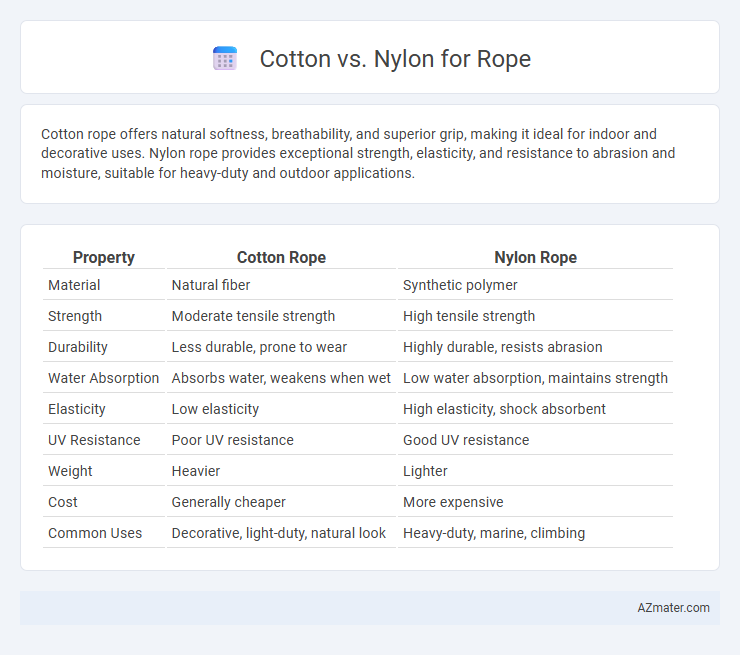Cotton rope offers natural softness, breathability, and superior grip, making it ideal for indoor and decorative uses. Nylon rope provides exceptional strength, elasticity, and resistance to abrasion and moisture, suitable for heavy-duty and outdoor applications.
Table of Comparison
| Property | Cotton Rope | Nylon Rope |
|---|---|---|
| Material | Natural fiber | Synthetic polymer |
| Strength | Moderate tensile strength | High tensile strength |
| Durability | Less durable, prone to wear | Highly durable, resists abrasion |
| Water Absorption | Absorbs water, weakens when wet | Low water absorption, maintains strength |
| Elasticity | Low elasticity | High elasticity, shock absorbent |
| UV Resistance | Poor UV resistance | Good UV resistance |
| Weight | Heavier | Lighter |
| Cost | Generally cheaper | More expensive |
| Common Uses | Decorative, light-duty, natural look | Heavy-duty, marine, climbing |
Introduction to Cotton and Nylon Ropes
Cotton ropes are made from natural fibers derived from the cotton plant, known for their softness, flexibility, and biodegradability, making them ideal for indoor use and decorative purposes. Nylon ropes are synthetic polymers recognized for their high tensile strength, elasticity, and resistance to abrasion, moisture, and chemicals, making them suitable for outdoor, marine, and industrial applications. Comparing cotton and nylon ropes highlights essential differences in durability, stretch, and environmental impact for selecting the appropriate rope type.
Material Composition and Structure
Cotton rope consists of natural cellulose fibers, providing softness and flexibility, while nylon rope is made from synthetic polyamide polymers, offering exceptional strength and elasticity. The twisted structure of cotton fibers results in a breathable, less durable rope prone to moisture absorption, whereas nylon's tightly woven filaments create a resilient, abrasion-resistant rope with superior tensile strength. Nylon's chemical composition also imparts resistance to UV damage and mildew, contrasting with the biodegradable nature of cotton.
Strength and Durability Comparison
Nylon ropes exhibit superior strength compared to cotton, with tensile strengths typically ranging from 7,000 to 9,000 psi, making them ideal for heavy-duty applications. Cotton ropes, while softer and more flexible, have significantly lower strength, generally around 2,500 to 3,000 psi, limiting their use in high-stress environments. In terms of durability, nylon is highly resistant to abrasion, UV exposure, and moisture, which prevents weakening over time, whereas cotton absorbs water, leading to faster degradation and reduced lifespan.
Flexibility and Handling
Cotton ropes offer superior flexibility and a softer, more natural feel, making them ideal for applications requiring easy knotting and comfortable handling. Nylon ropes are stronger and more elastic, providing excellent stretch and shock absorption but tend to be stiffer and less pliable than cotton. Choosing between cotton and nylon depends on whether flexibility and tactile comfort or strength and elasticity are the priority in rope use.
Moisture Absorption and Weather Resistance
Cotton rope offers superior moisture absorption, making it ideal for applications requiring grip when wet but prone to mildew and rot in damp conditions. Nylon rope excels in weather resistance with low moisture absorption, providing high strength, elasticity, and durability in harsh outdoor environments. Choosing between cotton and nylon depends on balancing the need for moisture handling versus exposure to prolonged weather elements.
Weight and Portability
Cotton ropes are significantly heavier and bulkier than nylon ropes, making them less ideal for portable applications where lightweight gear is essential. Nylon ropes offer a superior strength-to-weight ratio, allowing them to be more compact and easier to carry during outdoor activities such as climbing and camping. The lower weight and enhanced portability of nylon ropes contribute to improved user convenience and efficiency in various load-bearing scenarios.
Environmental Impact and Sustainability
Cotton ropes are biodegradable and derived from renewable plant sources, making them more environmentally sustainable compared to nylon ropes, which are synthetic and produced from non-renewable petroleum-based materials. Nylon rope manufacturing emits higher carbon footprints due to energy-intensive processes and releases harmful greenhouse gases, whereas cotton cultivation can sequester carbon but may require significant water and pesticide use. Choosing cotton over nylon enhances biodegradability and reduces long-term ecological harm, reinforcing sustainable material practices in rope production.
Common Applications and Uses
Cotton ropes are commonly used in decorative, crafts, and marine applications due to their softness, flexibility, and natural resistance to UV rays, making them ideal for indoor and outdoor use where comfort and aesthetics matter. Nylon ropes excel in heavy-duty, load-bearing, and safety-critical tasks such as climbing, towing, and rescue operations because of their high tensile strength, elasticity, and abrasion resistance. Both fibers serve distinct roles in rope manufacturing, with cotton favored for gentle handling and nylon preferred for demanding environments requiring durability and resilience.
Cost and Availability
Cotton rope is generally more affordable and widely available, especially in craft and home improvement stores, making it a cost-effective choice for light-duty applications. Nylon rope tends to be more expensive due to its synthetic manufacturing process but offers superior strength and durability, often stocked in specialized hardware and marine supply shops. Availability of nylon ropes may vary by region, whereas cotton ropes are easier to source globally.
Choosing the Right Rope: Cotton or Nylon?
Cotton ropes offer natural softness, excellent flexibility, and breathability, making them ideal for indoor use, decorative purposes, and tasks requiring minimal abrasion resistance. Nylon ropes provide superior strength, high elasticity, and excellent resistance to UV rays, chemicals, and moisture, making them suitable for heavy-duty, outdoor applications such as climbing, towing, and marine environments. Selecting between cotton and nylon ropes depends on whether priority is given to comfort and aesthetic or durability and performance in demanding conditions.

Infographic: Cotton vs Nylon for Rope
 azmater.com
azmater.com